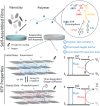Room-Temperature Phosphorescence Enabled through Nacre-Mimetic Nanocomposite Design
- PMID: 33346394
- PMCID: PMC11468592
- DOI: 10.1002/adma.202005973
Room-Temperature Phosphorescence Enabled through Nacre-Mimetic Nanocomposite Design
Abstract
A generic, facile, and waterborne strategy is introduced to fabricate flexible, low-cost nanocomposite films with room-temperature phosphorescence (RTP) by incorporating waterborne RTP polymers into self-assembled bioinspired polymer/nanoclay nanocomposites. The excellent oxygen barrier of the lamellar nanoclay structure suppresses the quenching effect from ambient oxygen (kq ) and broadens the choice of polymer matrices towards lower glass transition temperature (Tg ), while providing better mechanical properties and processability. Moreover, the oxygen permeation and diffusion inside the films can be fine-tuned by varying the polymer/nanoclay ratio, enabling programmable retention times of the RTP signals, which is exploited for transient information storage and anti-counterfeiting materials. Additionally, anti-interception materials are showcased by tracing the interception-induced oxygen history that interferes with the preset self-erasing time. Merging bioinspired nanocomposite design with RTP materials contributes to overcoming the inherent limitations of molecular design of organic RTP compounds, and allows programmable temporal features to be added into RTP materials by controlled mesostructures. This will assist in paving the way for practical applications of RTP materials as novel anti-counterfeiting materials.
Keywords: nacre-mimetics; nanocomposites; oxygen barrier; room-temperature phosphorescence.
© 2020 The Authors. Advanced Materials published by Wiley-VCH GmbH.
Conflict of interest statement
The authors declare no conflict of interest.
Figures




References
-
- a) Jiang K., Zhang L., Lu J., Xu C., Cai C., Lin H., Angew. Chem., Int. Ed. 2016, 55, 7231; - PubMed
- b) Lei Y., Dai W., Guan J., Guo S., Ren F., Zhou Y., Shi J., Tong B., Cai Z., Zheng J., Dong Y., Angew. Chem., Int. Ed. 2020, 59, 16054; - PubMed
- c) Huang Q. Q., Gao H. Q., Yang S. M., Ding D., Lin Z. H., Ling Q. D., Nano Res. 2020, 13, 1035.
-
- a) Yoshihara T., Hirakawa Y., Hosaka M., Nangaku M., Tobita S., J. Photochem. Photobiol., C 2017, 30, 71;
- b) Zhu C.‐Y., Wang Z., Mo J.‐T., Fan Y.‐N., Pan M., J. Mater. Chem. C 2020, 8, 9916;
- c) Wu L. Z., Liu X. Q., Zhang K., Gao J. F., Chen Y. Z., Tung C. H., Angew. Chem., Int. Ed. 2020, 59, 23456. - PubMed
-
- a) Ma X., Xu C., Wang J., Tian H., Angew. Chem., Int. Ed. 2018, 57, 10854; - PubMed
- b) Kenry, C. Chen , Liu B., Nat. Commun. 2019, 10, 2111; - PMC - PubMed
- c) Febriansyah B., Neo C. S. D., Giovanni D., Srivastava S., Lekina Y., Koh T. M., Li Y., Shen Z. X., Asta M., Sum T. C., Mathews N., England J., Chem. Mater. 2020, 32, 4431;
- d) Zhao W., He Z., Tang B. Z., Nat. Rev. Mater. 2020, 5, 869.
Grants and funding
LinkOut - more resources
Full Text Sources
Miscellaneous

